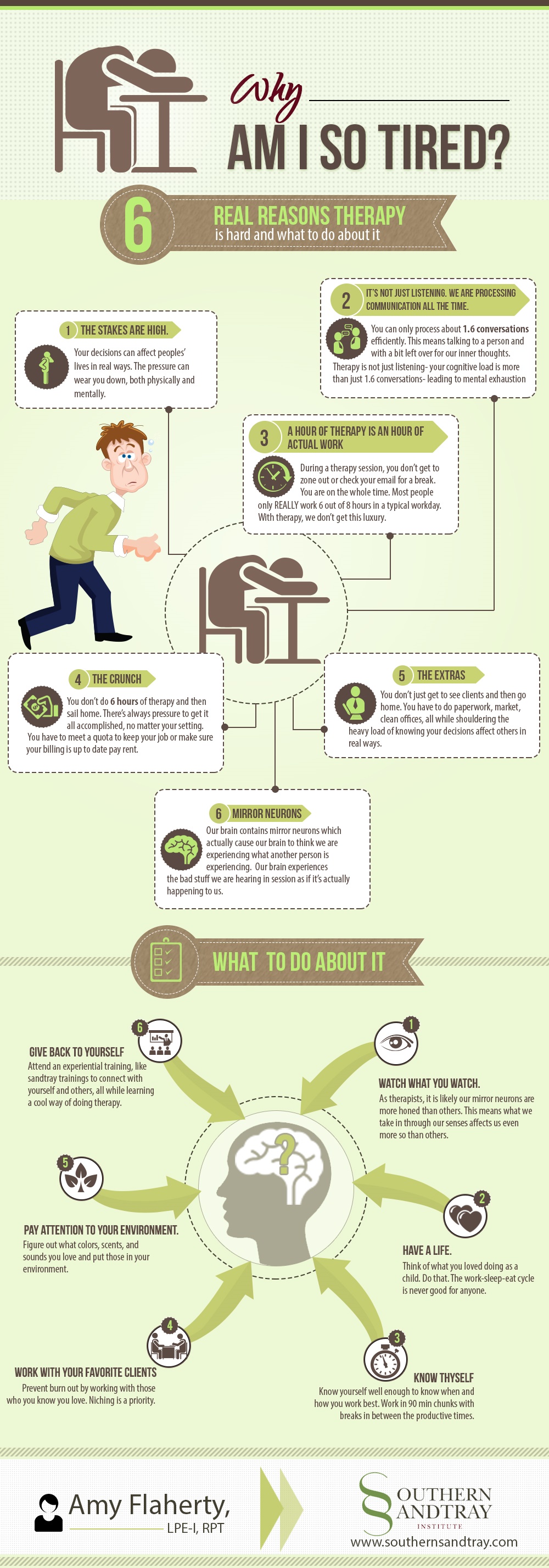Last week Amy Flaherty, LPE-I, RPT wrote a guest post talking about the One Thing That Every Psychotherapist’s Partner Doesn’t Get and she was kind enough to drop back in today to share an infographic she designed to continue the conversation.
__________________
An Infographic by Amy E. Flaherty, LPE-I, RPT

___________________
About the Author: Amy Flaherty, LPE-I is a Registered Play Therapist in Northeast Arkansas. She provides personalized trainings in sandtray therapy for all therapists (not just those who work with kids) through her business – the Southern Sandtray Institute.
in Northeast Arkansas. She provides personalized trainings in sandtray therapy for all therapists (not just those who work with kids) through her business – the Southern Sandtray Institute.
That is so cool, Amy! I love infographics and that one is spot on. I realized early on that I could only see “so many” clients in a row without getting very tired. I also realized that I had to be “on” the entire time I was with someone…we are listening hard for clues that tell us what is going on and how to help our clients. I loved this.
Linda,
Thanks for your kind words! I’m glad you liked it. I know it is always nice to have a “picture” of something. It helps me remember it and process the informationg more readily. I do love infographics.
Also- good luck Linda next month- scary but hope it will be worth it for you!
Linda, if only we are that good about being tuned in to what is going on in our own bodies!
This is great! It sums everything up so nicely, while providing workable solutions. Is there somewhere I can find this infographic so I can download and share with my students? It won’t let me do it here.
Hi, Carla! I didn’t realize you are teaching! Where and what are you teaching?
Hey Tamara! I was hired last summer at Kaplan University and I am an online adjunct professor. I started teaching the course Applied Skills in Human Services in September, so I am in my second term of teaching. I really enjoy it! Now that I have (almost) completed dissertation I am focusing more on expanding the practice and stepping back from all of my many roles.
And, should you every want me (or I’m betting Amy, too) to join you in your class via the internet, I / we would love to!
Sweet! Congrats to you on all your successes, Carla! Just realized I forgot to respond to you question. The easiest way in your online class might be to provide a link back to the webpage. And, after my posting error on this post, you can actually see what was supposed to get posted (meaning the infographic and the text right here).
I love this, Amy! I always tell clients that feeling uses our whole brains (vs. smelling, seeing, etc which are more localized in the brain). Hadn’t really every completed that thought by understanding myself better after a day of feeling with my clients.
I have long been on a media diet and stay away from things that are traumatizing or triggering, or, frankly, just too heavy. However, I struggle the most with #3 in terms of taking breaks and watching the work load. On the one hand, I thrive on excitement of working on marketing and having my phone ring because of my efforts to connect with potential clients. On the other, hand, I can get lost down a rabbit hole pretty easily only to look up and see a few hours has passed and I’ve missed breaks & some of the other non-work things on my list.
Allison, it’s so good to find your voice here today! Like you, I hadn’t really stopped to think through the physiology of why my work with some clients is more ehxausting and exhilarating than with others. Nor had I taken time to think through the correlations with the media until now. In hindsight, of course, it just seems like common sense. (Thanks, Amy!)
I have gone two years without turning on the TV at a time when I had experienced great loss. It turned out to be an amazing experience of great calm and I would highly recommend it to anyone whose “nerves are frayed.” And, then, for a longer period of time, I avoided certain triggering shows until I had cleaned up my issues around that .
I do want to add, though, that I believe that for mental health professionals who are triggered, there is an obligation to actively work on clearing those up or, at least strengthen the boundaries around those areas so that they do not contaminate the clinical work that we do. In my experience, areas that are triggered tend to generalize to other areas over time and will increasingly limit available options.
Allison, you sound like a natural marketer – or have at least tapped in to your inner marketer! Good for you! I, too, find more than enough rabbit holes to keep me busy for another 200 years! Oh, if only there were more hours in the day! It’s good to love what we do!
I love this! Is there some way I can save it in a PDF or something?
I suppose you might try taking a screenshot or photo of it? Maybe bookmark it instead?
First off, I have to say I LOVE THIS! I feel as though many people do not quite understand the mental strength it takes to be present and empathetic. I love how it is described as mirror neurons! Also about how we have to work the entire time, without breaks. These are all things true about the therapeutic process. We are not just listening, we are actively communicating, mirroring, participating, checking our own energies, managing the energies of others and so forth. Thanks Amy. I needed this validation after a 10 hour day!
Hi, Jocelyn! How nice to find your smiling face and voice here this morning! Thanks for dropping it today to chat!
Jocelyn,
Wow a 10 hour day! You deserve more than just validation, you need at least a massage!. Glad it could be helpful:)
I love visual learning as well. I have recently decided to really hone my niches and focus my practice exclusively on working with those niches. Thank you!